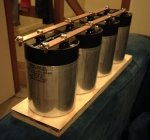- Joined
- Dec 4, 2016
- Messages
- 197
- Points
- 43
Hi to all, I have some experience in building and tweaking the ruby laser. Yes, the full-reflection prism works as a HR mirror, but you will lose at least a half of possible output energy, because the beam will become TEM10 single mode. I know from my experience that OC is needed with at least 45-50% of reflection\transmission for 694 nm. It may depend on the amount of Cr3+ dopant in the ruby crystal. Pale pink rubies need more reflection of the OC because the amplification ratio is lower than in deep red crystals. Anyway, 50% OC will give you reliable lasing with the prism or a proper HR mirror at the HR side.
What is the diameter of both? Mine was 8*120 mm and lasing started from around 1-1.2 kJ of pumping energy.
And yes, you'll have to deal with high voltage capacitors, be very careful!
Also look through Jarrod's laser worl site, he is very experienced in building ruby lasers from scratch, he also tried a very well polished copper coin as a HR and it worked.
Details on my ruby laser project are here. https://laserpointerforums.com/f50/laserbuilder-s-homebuilt-ruby-laser-99986.html
The Ruby Rod and Flash tube are approx 95 mm in length. (Active Area).
What is the diameter of both? Mine was 8*120 mm and lasing started from around 1-1.2 kJ of pumping energy.
And yes, you'll have to deal with high voltage capacitors, be very careful!
Also look through Jarrod's laser worl site, he is very experienced in building ruby lasers from scratch, he also tried a very well polished copper coin as a HR and it worked.
Details on my ruby laser project are here. https://laserpointerforums.com/f50/laserbuilder-s-homebuilt-ruby-laser-99986.html





